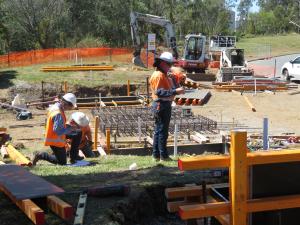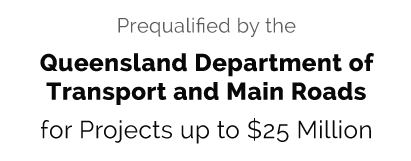It wouldn’t be an overstatement to say that every industry in Australia has felt the effects of the ongoing pandemic. While the worst appears to now be behind us, reduced demand for goods and services unfortunately continues1. As we move forward, however, there is cause for economic optimism, and civil infrastructure is largely to thank for that.
Australia’s Saving Grace
While growth in the civil infrastructure space has been predicted by the Australian Bureau of Statistics for quite some time2, what was less apparent was just how vital this industry would prove for the sunburnt country throughout 2020.
Bucking the sharp downward trends experienced by many other industries, civil infrastructure held fast through undoubtedly trying circumstances, and looks set to stimulate the economy into the future.
Infrastructure Australia Chief Executive Romilly Madew articulated this when discussing the Infrastructure beyond COVID-19: A national study on the impacts of the pandemic on Australia report.
“COVID-19 has put a pause on the traditional driver of infrastructure, Net Overseas Migration, however the pace of change in the sector has generally increased, with new emerging trends,” Madew said.
“The continuation of infrastructure construction across major projects was a key source of economic activity and employment during the pandemic, and ensured we took advantage of the three-year pause in population growth”3.
Though the industry handled well the challenges of this ‘new-normal’, it’s caused a seismic rethink of future approaches to civil infrastructure.
Civil Infrastructure May Never Be The Same
Until 2020, civil infrastructure use had been following a predictable pattern. Public transport was slowly but surely gaining popularity, per capita waste generation was in steady decline, and urban centres were still very much the focal point for infrastructure demand and development. However, like nearly every other facet of our society, the impact of the pandemic on these trends has been profound4.
With crowded public transport considered a risky method of commuting, second hand car purchases spiked. This caused road traffic to swiftly return to near pre-COVID levels, and Infrastructure Victoria expects it will soon surpass those figures by 15 per cent5. Conversely, train and bus journeys have plummeted by nearly 50 per cent6.
The increase in congestion comes despite many Australians opting to work from home. While somewhat easing the burden on roads and highways, this trend presents its own unique challenges to existing infrastructure. Home water use experienced a marked rise during COVID-induced lockdowns7, as did the waste produced per person. Meanwhile, the added pressure on broadband networks forced the NBN to release 40 per cent more latent capacity8.
It’s important to note that these heightened demands were largely experienced outside CBDs, where utilities are often not quite so robust. It’s likely that the pressure on these systems will only grow, with net migration from capital cities to regional areas recently experiencing a 200 per cent increase9.
What You’ll See In The Coming Years
As the needs and preferences of society shift, so too must the focus of civil infrastructure works. The following trends will help mitigate the aforementioned challenges, and propel Australia’s economic resurgence.
Heightened Opportunity
Overall, the industry is expected to grow significantly in the near future10. This is thanks in no small part to the Federal Government’s JobMaker Plan, which has added a further $10 billion to what is now a $110 billion commitment to infrastructure investment over the next 10 years11. With travel restrictions resulting in a lack of skilled migrant workers, plenty of opportunities await Australians wishing to enter the civil industry.
Some of the major projects set to begin in the South-East Queensland region include the interstate inland rail, upgrades to the M1 Motorway, the Coomera Connector Corridor, extension of the Gold Coast’s light rail system, and ongoing high-rise development.
Regionalisation
As Aussies flock to more regional areas (both as tourists and residents), local infrastructure must adapt accordingly. Expect to see subdivision, roads, and water projects storming ahead in these communities to cater to the demand for affordable regional housing12. There is also a push to upgrade existing regional telecommunications networks to enable faster digital connections13.
Focus on Green Spaces
An interesting side-effect of the pandemic has been an uptick in localism – that is, the utilisation of local amenities. Throughout the past year there has been a 23 per cent increase in the use of national parks14, and research indicates rising appreciation among Australian communities for these green spaces. Continuing to develop such environments will be a key concern of the civil industry moving forward.
Increased Government and Industry Collaboration
It’s clear that in order to achieve timely and effective civil outcomes, collaboration between government and industry is vital. Thankfully, both parties have shown a great deal of promise in this regard. Together they’ve already navigated dramatic changes to community behaviour and network requirements, and rapidly pivoted their services. Romilly Madew spoke to this point when she said: “COVID-19 has demonstrated that there is an opportunity to make better use of what we have. This is a trend that both governments and industry should harness as we consider the infrastructure investment and reform responses that will best support Australia’s long-term economic recovery”15.
Conclusion
While COVID has presented significant challenges to the Australian economy, the civil infrastructure industry remains strong. However, changing market forces have highlighted the need for adaptable, forward-thinking, and collaborative civil experts that can meet the needs of this evolving landscape.
The leading civil contractors for Queensland and northern New South Wales, OM Civil stand ready to deliver such solutions. Working with an open-book, transparent approach, OM Civil has a proven track record spanning a plethora of landscaping, subdivisions, utilities, roads, industrial, and environmental rehabilitation projects. Responsible for critical infrastructure in coastal, regional, and metropolitan areas, OM Civil staff pride themselves on working with clients at every stage of the project. Contact the friendly team today to discover civil infrastructure outcomes that stand the test of time.
References
- https://www.abs.gov.au/articles/one-year-covid-19-aussie-jobs-business-and-economy
- https://nationalindustryinsights.aisc.net.au/industries/mining-drilling-and-civil-infrastructure/civil-infrastructure
- https://www.roadsonline.com.au/covid-19-report-shows-accelerated-changes-in-infrastructure-trends/
- https://www.infrastructureaustralia.gov.au/sites/default/files/2020-12/Final_COVID%20Impacts%20on%20Infrastructure%20Sectors%20Report_14%20Dec%202020.pdf
- https://www.theage.com.au/national/victoria/extra-car-trips-more-congestion-slower-speeds-the-covid-impact-on-commuting-20210119-p56v5b.html
- https://www.smh.com.au/national/road-traffic-returns-to-pre-covid-levels-as-commuters-shun-public-transport-20210129-p56xw7.html
- https://www.abc.net.au/news/2020-11-24/adelaideans-turn-on-the-waterworks-during-covid-19-lockdown/12914534
- https://www.ceda.com.au/NewsAndResources/Opinion/Infrastructure/The-five-trends-shaping-infrastructure-after-COVID
- https://www.insidewaste.com.au/index.php/2021/01/18/covid-accelerated-structural-infrastructure-shifts/
- https://www.training.com.au/ed/australias-employable-industries-post-pandemic/
- https://www.gtlaw.com.au/insights/australian-federal-budget-2020-21-infrastructure-package
- https://www.infrastructureaustralia.gov.au/sites/default/files/2021-03/IFA_301237_2021%20Infrastructure%20Priority%20List%20FA2%20Navigable%20WEB%20Flat%20EXT%20FINAL_update.pdf
- https://www.infrastructureaustralia.gov.au/listing/speech/challenges-and-opportunities-regional-infrastructure-investment
- https://www.brisbanetimes.com.au/national/queensland/how-queensland-s-national-parks-generate-billions-every-year-20201009-p563kk.html
- https://www.insideconstruction.com.au/section/professional-services/covid-19-accelerated-changes-in-infrastructure-report/



 BUS270
BUS270  license no. 15194376
license no. 15194376 
